Maths / Mathematics
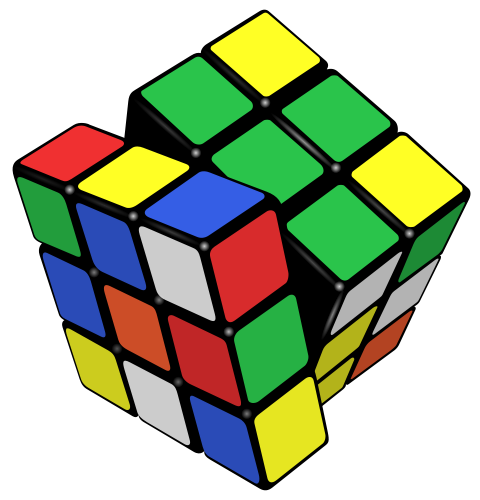
The word mathematics comes from the Greek μάθημα (máthēma), which, in the ancient Greek language, means "that which is learnt", "what one gets to know," hence also "study" and "science", and in modern Greek just "lesson." The word máthēma is derived from μανθάνω (manthano), while the modern Greek equivalent is μαθαίνω (mathaino), both of which mean "to learn." In Greece, the word for "mathematics" came to have the narrower and more technical meaning "mathematical study" even in Classical times. Its adjective is μαθηματικός (mathēmatikós), meaning "related to learning" or "studious", which likewise further came to mean "mathematical". In particular, μαθηματικὴ τέχνη (mathēmatikḗ tékhnē), Latin: ars mathematica, meant "the mathematical art".
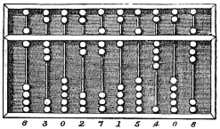
![]() An abacus, a simple calculating tool used since ancient times.
An abacus, a simple calculating tool used since ancient times.
Mathematics is the abstract study of topics such as quantity (numbers), structure, space, and change. There is a range of views among mathematicians and philosophers as to the exact scope and definition of mathematics.
Mathematicians seek out patterns and use them to formulate new conjectures. Mathematicians resolve the truth or falsity of conjectures by mathematical proof. When mathematical structures are good models of real phenomena, then mathematical reasoning can provide insight or predictions about nature. Through the use of abstraction and logic, mathematics developed from counting, calculation, measurement, and the systematic study of the shapes and motions of physical objects. Practical mathematics has been a human activity for as far back as written records exist. The research required to solve mathematical problems can take years or even centuries of sustained inquiry.
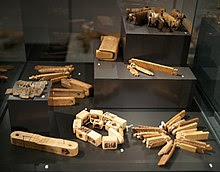
Single and split tallies from the Swiss Alps, 18th to early 20th century (Swiss Alpine Museum) Evidenced by tallies found on bone, in addition to recognizing how to count physical objects, prehistoric peoples may have also recognized how to count abstract quantities, like time - days, seasons, years.
More complex mathematics did not appear until around 3000 BC, when the Babylonians and Egyptians began using arithmetic, algebra and geometry for taxation and other financial calculations, for building and construction, and for astronomy. The earliest uses of mathematics were in trading, land measurement, painting and weaving patterns and the recording of time.
In Babylonian mathematics elementary arithmetic (addition, subtraction, multiplication and division) first appears in the archaeological record. Numeracy pre-dated writing and numeral systems have been many and diverse, with the first known written numerals created by Egyptians in Middle Kingdom texts such as the Rhind Mathematical Papyrus.
Between 600 and 300 BC the Ancient Greeks began a systematic study of mathematics in its own right with Greek mathematics.
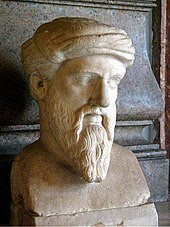
Greek mathematician Pythagoras (c. 570 - c. 495 BC)

A Greek mathematician (possibly Euclid or Archimedes) performing a geometric construction with a compass, from The School of Athens by Raphael
Euclidean geometry is a mathematical system attributed to the Alexandrian Greek mathematician Euclid, which he described in his textbook on geometry: the Elements. Euclid's method consists in assuming a small set of intuitively appealing axioms, and deducing many other propositions (theorems) from these. Although many of Euclid's results had been stated by earlier mathematicians,[1] Euclid was the first to show how these propositions could fit into a comprehensive deductive and logical system.[
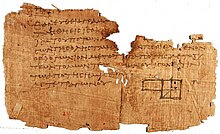
Oxyrhynchus papyrus (P.Oxy. I 29) showing fragment of Euclid's Elements
In mathematics, non-Euclidean geometry is a small set of geometries based on axioms closely related to those specifying Euclidean geometry. As Euclidean geometry lies at the intersection of metric geometry and affine geometry, non-Euclidean geometry arises when either the metric requirement is relaxed, or the parallel postulate is set aside. In the latter case one obtains hyperbolic geometry and elliptic geometry, the traditional non-Euclidean geometries. When the metric requirement is relaxed, then there are affine planes associated with the planar algebras which give rise to kinematic geometries that have also been called non-Euclidean geometry.

The statue of the two Bolyai (Izsák Márton and Csorvássy István )
The beginning of the 19th century would finally witness decisive steps in the creation of non-Euclidean geometry. Circa 1813, Carl Friedrich Gauss and independently around 1818, the German professor of law Ferdinand Karl Schweikart had the germinal ideas of non-Euclidean geometry worked out, but neither published any results. Then, around 1830, the Hungarian mathematician János Bolyai and the Russian mathematician Nikolai Ivanovich Lobachevsky separately published treatises on hyperbolic geometry. Consequently, hyperbolic geometry is called Bolyai-Lobachevskian geometry, as both mathematicians, independent of each other, are the basic authors of non-Euclidean geometry. Gauss mentioned to Bolyai's father, when shown the younger Bolyai's work, that he had developed such a geometry several years before, though he did not publish. While Lobachevsky created a non-Euclidean geometry by negating the parallel postulate, Bolyai worked out a geometry where both the Euclidean and the hyperbolic geometry are possible depending on a parameter k. Bolyai ends his work by mentioning that it is not possible to decide through mathematical reasoning alone if the geometry of the physical universe is Euclidean or non-Euclidean; this is a task for the physical sciences.
Connect With Us